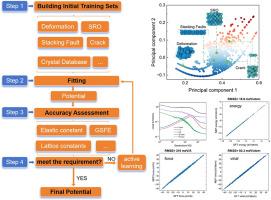Exploring the formation and mechanical significance of short-range ordering in W-Mo-V-based on neuroevolution potential
IF 9.7
2区 材料科学
Q1 MATERIALS SCIENCE, MULTIDISCIPLINARY
引用次数: 0
Abstract
This study investigates the formation and mechanical implications of short-range ordering (SRO) in W-Mo-V-based medium-entropy alloys (MEAs) through a combination of neuroevolution potential (NEP), density functional theory (DFT) calculations, and molecular dynamics (MD) simulations. The atomic-scale mechanisms of SRO and its effects on strength, ductility, and toughness were systematically analyzed. Results reveal that SRO originates from the affinity between Mo-V and W-W atomic pairs, significantly enhancing yield strength by increasing lattice friction and slip energy barriers. However, SRO-induced strain localization concentrates deformation within narrow nano-slip bands, suppressing dislocation interactions across multiple slip systems and reducing work-hardening capability. MD simulations of crack propagation further demonstrate that SRO accelerates crack growth while diminishing amorphous phase formation, thereby compromising material toughness. The study elucidates the dual role of SRO in improving strength while exacerbating the strength-ductility trade-off, providing critical insights for designing next-generation structural materials with balanced mechanical performance.


基于神经进化电位的w - mo - v近程有序的形成及其力学意义
本研究通过结合神经进化势(NEP)、密度泛函理论(DFT)计算和分子动力学(MD)模拟,研究了w - mo - v基中熵合金(MEAs)中短程有序(SRO)的形成及其力学意义。系统分析了SRO的原子尺度机理及其对强度、延展性和韧性的影响。结果表明,SRO源于Mo-V和W-W原子对之间的亲和关系,通过增加晶格摩擦和滑移能垒显著提高屈服强度。然而,sro诱导的应变局部化将变形集中在狭窄的纳米滑移带内,抑制了多个滑移系统之间的位错相互作用,降低了加工硬化能力。裂纹扩展的MD模拟进一步表明,SRO加速了裂纹扩展,同时减少了非晶相的形成,从而影响了材料的韧性。该研究阐明了SRO在提高强度同时加剧强度-延性权衡方面的双重作用,为设计具有平衡机械性能的下一代结构材料提供了重要见解。
本文章由计算机程序翻译,如有差异,请以英文原文为准。
求助全文
约1分钟内获得全文
求助全文
来源期刊

Materials Today Physics
Materials Science-General Materials Science
CiteScore
14.00
自引率
7.80%
发文量
284
审稿时长
15 days
期刊介绍:
Materials Today Physics is a multi-disciplinary journal focused on the physics of materials, encompassing both the physical properties and materials synthesis. Operating at the interface of physics and materials science, this journal covers one of the largest and most dynamic fields within physical science. The forefront research in materials physics is driving advancements in new materials, uncovering new physics, and fostering novel applications at an unprecedented pace.
 求助内容:
求助内容: 应助结果提醒方式:
应助结果提醒方式:


